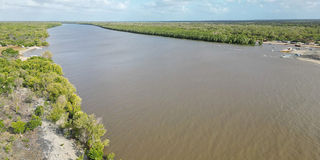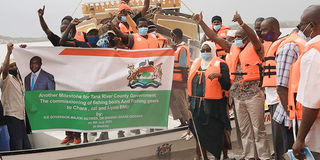Tana River County Government intensifies drive to restore Kenya’s major wetland
Sponsored by County Government of Tana River

The natural beauty of Tana River County wetlands.
Background
Tana Delta in Kenya is one of the largest and most significant coastal delta ecosystems in Eastern Africa.
The delta consists of an impressive variety of freshwater, floodplain, estuarine and coastal areas, with extensive mangroves, intertidal areas, and pristine beaches, forming a large and very productive coastal ecosystem. Thus, in 2012, it was designated as Kenya’s 6th Ramsar Wetland of International Importance.
The Tana Delta is rich in nature, supporting several highly threatened species of animals and plants. These include five species of threatened marine turtles, the International Union for Conservation of Nature (IUCN) red-listed African elephant, and three species of monkey. It supports tens of thousands of water birds, making it one of the key sites in the country for the conservation of water birds. The delta also supports over 250,000 people. But due to climate changes and human activities, it at some point lost its glory, with the following notable effects:
- Drying of lakes and swamps.
- Frequent changes in the course of the river, thus affecting flooding patterns.
- The intrusion of seawater into terrestrial areas due to a rise in sea level, thereby damaging forests and farmlands, e.g. Kalota Brook. The scenario is exacerbated by reduced volumes of water in River Tana.
- Extinction of indigenous trees.
- The disappearance of migratory birds.
- Overgrazing of Tana River Delta Wetland.
- Unsustainable harvesting of riverine and indigenous forests.
Previously, farmers used to practise recession farming from flood water around the delta, harvesting their farm produce twice per year. There was food security throughout the year. Currently, farmers are food insecure and are dependent on relief.
Tana Delta served as a fall-back area to pastoralists during the dry season, thus reducing the negative impacts of drought on their livestock. Currently, poverty levels are on the rise because of the loss of animals. A report by the Kenya National Bureau of Statistics (KNBS) indicates that the poverty level in the Tana Delta has increased to 69 percent from the 62 percent reported in 2019, thus increasing the vulnerability of adjacent communities to external calamities such as drought, floods, and conflict. Fishing from the lake, river and swamps in the delta is now a dream to the communities living nearby.
Wildlife has been affected too, and the change in biodiversity has created displacement and human-wildlife conflict. There are no longer migratory birds from Europe and the rest of the world due to the above changes in the Tana Delta ecosystem.
Other social and economic effects include school dropouts and drug abuse by the youth, early marriages, charcoal burning, and rural-urban migration.
The situation in Tana Delta wetlands demands urgent intervention. River water siltation is increasing at a high rate. Lakes and swamps are drying up, and forest cover is decreasing. The livelihood of more than 100,000 has been affected. Therefore, a joint effort by all stakeholders, including the county government, national government, NGOs, private sector organisations, civil society groups, and UN agencies, among others, is necessary.
Policy intervention is required to control the construction of mega dams in upper Tana because this affects the downstream people like Tana River residents. The people in upper Tana are continuing to initiate irrigation projects, which will have vast effects on community livelihoods and biodiversity in general, downstream.
Interventions by the County Government
Tana River County Governor, Dr Dhadho Godhana, has initiated a programme whose overall objective is to restore the Tana Delta wetland ecosystem through water conservation and afforestation, and community empowerment.
One of the initiatives is the planting of five million trees. This already started in Kipini. The other is the reclamation of Lake Shakababo. Once reputed as the biggest ox-bow lake in Africa, this lake dried up at some point and remained so for more than 20 years due to the siltation of its inlet. However, today, the lake gets water during flooding seasons, and the county’s Department of Fisheries has provided fingerlings towards reviving fishing activity as means of livelihood.
The County Government is also sensitising local communities on the importance of environmental protection. This has been going on through the leadership of the Tana River County Department of Environment and Climate Change, in collaboration with other stakeholders.

H.E the Governor of Tana River County, Maj (Rtd) Dr Dhadho Godhana (with hands raised), during the commissioning of four fishing boats and fishing gears for use by the beach management units of Chara, Kipini, and Ozi, at Shekiko, Tana Delta Sub-County. This is an aspect of the alternative sustainable livelihood programme by the Tana River County Government.
The County Government has additionally enacted laws and drafted policies to enhance biodiversity conservation as well as climate change adaptation and mitigation. These legal instruments include:
- The Tana River County Climate Change Act 2021
- The Draft Tana River County Climate Change Finance Policy
- The Draft Tana River County Forest Policy
- The Draft Tana River County Environment Policy
- The Tana River County Environment Bill
- The Tana Forest and Landscape Restoration Action Plan.
Additionally, the County Government is working with several partners, including the Kenya Forest Service (KFS), Kenya Wildlife Service (KWS), National Environment Management Authority (NEMA), Kenya Forestry Research Institute (KEFRI), Kenya Marine and Fisheries Research Institute (KMFRI), and Nature Kenya, to restore the Tana River Delta Wetland. Other institutions the county is collaborating with are World Food Programme (WFP), Northern Rangelands Trust Coast Regional Office, Eden Reforestation Project, Wetlands International, World Vision Kenya, Comitato Internazionale per Sviluppo dei Popoli (CISP), and Groots Kenya.
Other activities to be undertaken under the governor’s programme
- Closing of brooks that flood sea water into the river, e.g. Kalota Brook.
- Rectifying the frequent change of river course at Matomba and Handarku.
- Opening of water inlets for dried lakes in the delta – Kongolola, Chalalu, and others.
- Afforestation.
- Community empowerment through the provision of solar-powered irrigation systems.
- Training of community groups on the conservation of water resources and forests, as well as on the existing policies on water resources.
- Training and equipping of beach management units (BMU).
- Mangrove assessment and restoration initiatives.
- Engagement of community conservancies, community forest associations (CFAs), and water resources users’ associations.


